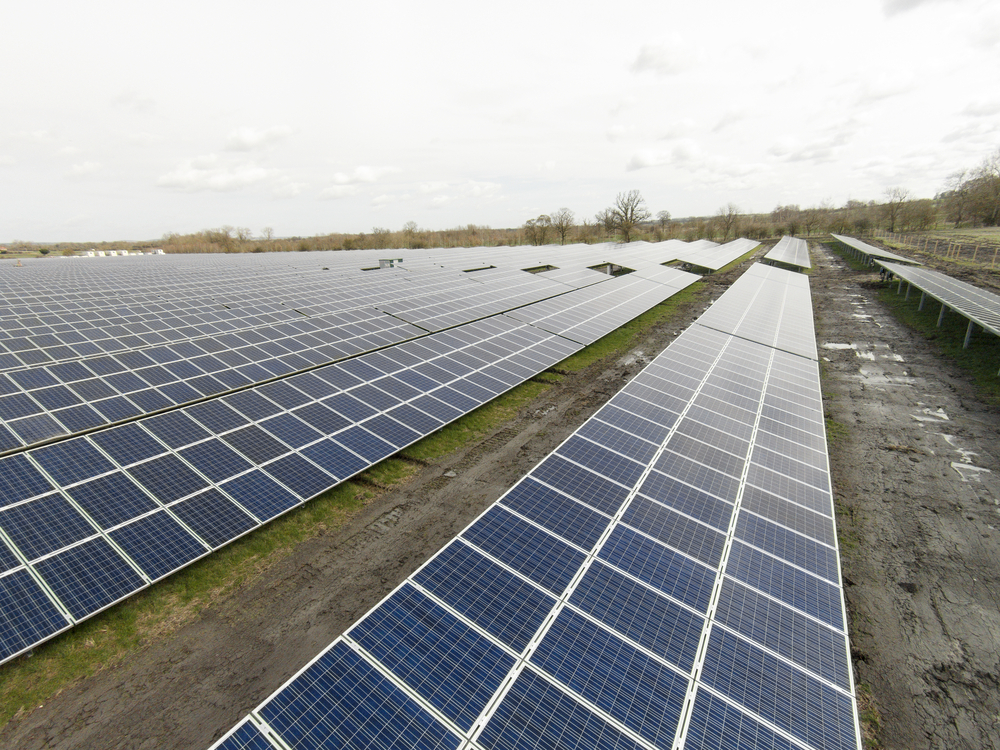Solar Farms: Save on Construction and Future Maintenance Costs with Tensar InterAx Geogrid
by Rodrigo Valencia, on April 11, 2023
 Rapid technology improvements and decreasing cost of solar energy resources, along with the increased competitiveness of battery storage, have made solar one of the most competitive energy sources. It's no wonder that the development of solar farms is expected accelerate rapidly over in the next few years. However, new sites are often located in remote or protected areas or in prime farmland. In many cases, the underlying soil conditions are unfavorable, characterized by soft, expansive, high-plasticity clays, silts or peats and with high water tables. This creates a massive and expensive challenge for solar farm developers and contractors who build access roads, laydown yards or platforms that must support heavy loads and construction vehicles.
Rapid technology improvements and decreasing cost of solar energy resources, along with the increased competitiveness of battery storage, have made solar one of the most competitive energy sources. It's no wonder that the development of solar farms is expected accelerate rapidly over in the next few years. However, new sites are often located in remote or protected areas or in prime farmland. In many cases, the underlying soil conditions are unfavorable, characterized by soft, expansive, high-plasticity clays, silts or peats and with high water tables. This creates a massive and expensive challenge for solar farm developers and contractors who build access roads, laydown yards or platforms that must support heavy loads and construction vehicles.
Tensar InterAx geogrid is the proven answer for building high-performance, long-lasting access roads and platforms in solar farm developments. By incorporating Tensar geogrids, a mechanically stabilized layer is created by keeping the aggregate layer confined and strong. This results in less haul-off of excavated material and reduces the required aggregate to be imported, placed, and compacted. Construction savings of up to 70% can be realized.
There are many benefits of using Tensar InterAx geogrid on the construction of solar farm sites:
- Use Less Aggregate: Accepted design methodologies have demonstrated that the required aggregate thickness can be reduced by up to 70% with Tensar geogrid. There is little to no undercut and it’s possible to build these structures at grade.
- Speed Construction Time: Geogrid installation is extremely simple. No specialized equipment is required. Also, the use of less aggregate leads to a faster installation compared to other solutions using conventional soil stabilization methods.
- Avoid Over-Excavation: Traditional stabilization often involves expansive excavation and disposal of the uppermost subgrade soils. With Tensar geogrid, there is little to no undercut and it’s possible to build these structures at grade.
- Eliminate Uncertainties Associated with Chemical Stabilization: Apart from the obvious environmental concerns, using chemical treatment of the subgrade like lime and cement requires optimum temperatures and dry weather conditions be met. This risky method can lead to delays in the construction.
Once a solar farm has been built, reliable site access after construction is important. Maintenance workers often go back to the site to inspect, clean, repair or replace solar panels or other components which means shutting down an access road for frequent repairs is costly for operations. And, when emergency strikes, dependable access to these sites is critical.
With decades of in-ground performance, Tensar geogrid is proven to reduce maintenance costs since it increases the bearing capacity of the subgrade and maintains its capabilities over time. With enhanced load distribution, subgrade failures can be prevented and creates safer, more reliable roadways. This means sites stay productive and less money is spent over the long-term for repairs.
Additionally, when solar sites are hit with rain, or are coming out of the winter thaw, bearing capacities of the subgrade soils can decrease dramatically. What might have been a firm access road becomes a wet, rutted mess, compromising production rates. Access roads stabilized with Tensar geogrid will avoid cold and rain-related issues since the geogrid strengthens bearing capacities of the subgrade, keeping them firm in wet conditions.
PROVEN PERFORMANCE
Solar Park
Webberville, TX
The Challenge: The project required more than 55,000 square meters of subgrade stabilization, internal roads, maintenance facilities, and foundations for the construction of the park's main structures. These structures required adequate bearing capacity. Clayey soils of high plasticity present in the area prevented the access of heavy equipment to the area to carry out the removal of the site material and the proper stabilization of the subgrade.
The Solution: Using Tensar’s software, our dealer was able to offer a cost-effective engineering solution to high-plasticity clay soil problems at the job site. A solution made up of Tensar geogrid allowed not only immediate access to the site without the need to excavate in the area, but also allowed the optimization of the structure, achieving a lower thickness of the base and the asphalt layer. This translated into considerable savings in material and transport costs and increased the bearing capacity of the subgrade, which in turn will guarantee our client less frequent maintenance of the internal roads of the project.
Contact us for more information on Tensar solutions for solar farms:
Email: TensarMarketing-WH@cmc.com
Online: www.TensarCorp.com
Call: 800-TENSAR-1




